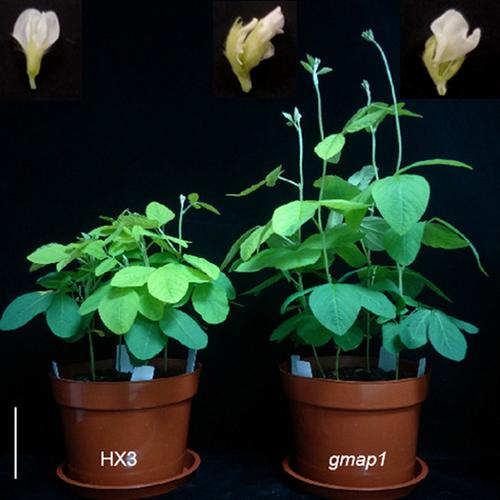当前位置:
X-MOL 学术
›
J. Integr. Plant Biol.
›
论文详情
Our official English website, www.x-mol.net, welcomes your
feedback! (Note: you will need to create a separate account there.)
Soybean AP1 homologs control flowering time and plant height.
Journal of Integrative Plant Biology ( IF 9.3 ) Pub Date : 2020-07-03 , DOI: 10.1111/jipb.12988 Liyu Chen 1 , Haiyang Nan 1 , Lingping Kong 1 , Lin Yue 1 , Hui Yang 1 , Qingsong Zhao 2 , Chao Fang 1 , Haiyang Li 1, 3 , Qun Cheng 1 , Sijia Lu 1 , Fanjiang Kong 1, 4 , Baohui Liu 1, 4 , Lidong Dong 1
Journal of Integrative Plant Biology ( IF 9.3 ) Pub Date : 2020-07-03 , DOI: 10.1111/jipb.12988 Liyu Chen 1 , Haiyang Nan 1 , Lingping Kong 1 , Lin Yue 1 , Hui Yang 1 , Qingsong Zhao 2 , Chao Fang 1 , Haiyang Li 1, 3 , Qun Cheng 1 , Sijia Lu 1 , Fanjiang Kong 1, 4 , Baohui Liu 1, 4 , Lidong Dong 1
Affiliation

|
Flowering time and plant height are key agronomic traits that directly affect soybean (Glycine max) yield. APETALA1 (AP1) functions as a class A gene in the ABCE model for floral organ development, helping to specify carpel, stamen, petal, and sepal identities. There are four AP1 homologs in soybean, all of which are mainly expressed in the shoot apex. Here, we used clustered regularly interspaced short palindromic repeats (CRISPR) – CRISPR‐associated protein 9 technology to generate a homozygous quadruple mutant, gmap1, with loss‐of‐function mutations in all four GmAP1 genes. Under short‐day (SD) conditions, the gmap1 quadruple mutant exhibited delayed flowering, changes in flower morphology, and increased node number and internode length, resulting in plants that were taller than the wild type. Conversely, overexpression of GmAP1a resulted in early flowering and reduced plant height compared to the wild type under SD conditions. The gmap1 mutant and the overexpression lines also exhibited altered expression of several genes related to flowering and gibberellic acid metabolism, thereby providing insight into the role of GmAP1 in the regulatory networks controlling flowering time and plant height in soybean. Increased node number is the trait with the most promise for enhancing soybean pod number and grain yield. Therefore, the mutant alleles of the four AP1 homologs described here will be invaluable for molecular breeding of improved soybean yield.
中文翻译:

大豆 AP1 同源物控制开花时间和株高。
开花时间和株高是直接影响大豆( Glycine max )产量的关键农艺性状。 APETALA1 ( AP1 ) 在花器官发育的 ABCE 模型中充当 A 类基因,有助于确定心皮、雄蕊、花瓣和萼片的身份。大豆中有四种AP1同源物,均主要在茎尖表达。在这里,我们使用成簇规则间隔短回文重复序列 (CRISPR) – CRISPR 相关蛋白 9 技术来生成纯合四重突变体gmap1 ,在所有四个GmAP1基因中均具有功能丧失突变。在短日照(SD)条件下, gmap1四重突变体表现出开花延迟、花形态变化、节数和节间长度增加,导致植物比野生型更高。相反,在 SD 条件下,与野生型相比, GmAP1a的过度表达导致开花提前并降低植物高度。 gmap1突变体和过表达系还表现出与开花和赤霉酸代谢相关的几个基因的表达改变,从而深入了解GmAP1在控制大豆开花时间和株高的调控网络中的作用。节数增加是最有希望提高大豆荚数和谷物产量的性状。因此,这里描述的四种AP1同源物的突变等位基因对于提高大豆产量的分子育种将具有无价的价值。
更新日期:2020-07-03
中文翻译:

大豆 AP1 同源物控制开花时间和株高。
开花时间和株高是直接影响大豆( Glycine max )产量的关键农艺性状。 APETALA1 ( AP1 ) 在花器官发育的 ABCE 模型中充当 A 类基因,有助于确定心皮、雄蕊、花瓣和萼片的身份。大豆中有四种AP1同源物,均主要在茎尖表达。在这里,我们使用成簇规则间隔短回文重复序列 (CRISPR) – CRISPR 相关蛋白 9 技术来生成纯合四重突变体gmap1 ,在所有四个GmAP1基因中均具有功能丧失突变。在短日照(SD)条件下, gmap1四重突变体表现出开花延迟、花形态变化、节数和节间长度增加,导致植物比野生型更高。相反,在 SD 条件下,与野生型相比, GmAP1a的过度表达导致开花提前并降低植物高度。 gmap1突变体和过表达系还表现出与开花和赤霉酸代谢相关的几个基因的表达改变,从而深入了解GmAP1在控制大豆开花时间和株高的调控网络中的作用。节数增加是最有希望提高大豆荚数和谷物产量的性状。因此,这里描述的四种AP1同源物的突变等位基因对于提高大豆产量的分子育种将具有无价的价值。










































 京公网安备 11010802027423号
京公网安备 11010802027423号